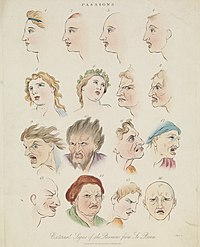
Photo from wikipedia
Both affective states and personality traits shape how we perceive the social world and interpret emotions. The literature on affective priming has mostly focused on brief influences of emotional stimuli… Click to show full abstract
Both affective states and personality traits shape how we perceive the social world and interpret emotions. The literature on affective priming has mostly focused on brief influences of emotional stimuli and emotional states on perceptual and cognitive processes. Yet this approach does not fully capture more dynamic processes at the root of emotional states, with such states lingering beyond the duration of the inducing external stimuli. Our goal was to put in perspective three different types of affective states (induced affective states, more sustained mood states and affective traits such as depression and anxiety) and investigate how they may interact and influence emotion perception. Here, we hypothesized that absorption into positive and negative emotional episodes generate sustained affective states that outlast the episode period and bias the interpretation of facial expressions in a perceptual decision-making task. We also investigated how such effects are influenced by more sustained mood states and by individual affect traits (depression and anxiety) and whether they interact. Transient emotional states were induced using movie-clips, after which participants performed a forced-choice emotion classification task with morphed facial expressions ranging from fear to happiness. Using a psychometric approach, we show that negative (vs. neutral) clips increased participants’ propensity to classify ambiguous faces as fearful during several minutes. In contrast, positive movies biased classification toward happiness only for those clips perceived as most absorbing. Negative mood, anxiety and depression had a stronger effect than transient states and increased the propensity to classify ambiguous faces as fearful. These results provide the first evidence that absorption and different temporal dimensions of emotions have a significant effect on how we perceive facial expressions.
Journal Title: PLoS ONE
Year Published: 2017
Link to full text (if available)
Share on Social Media: Sign Up to like & get
recommendations!